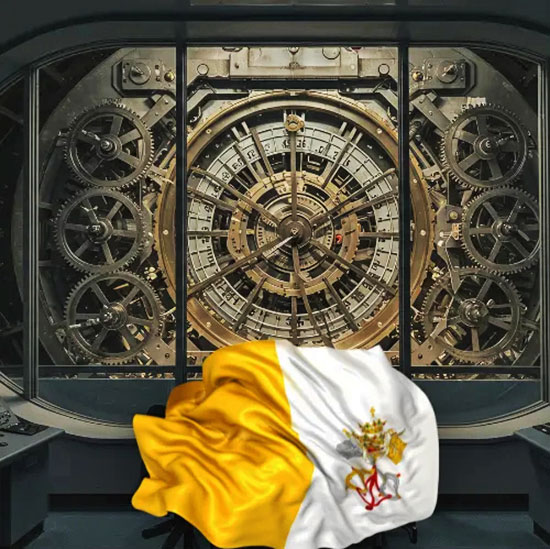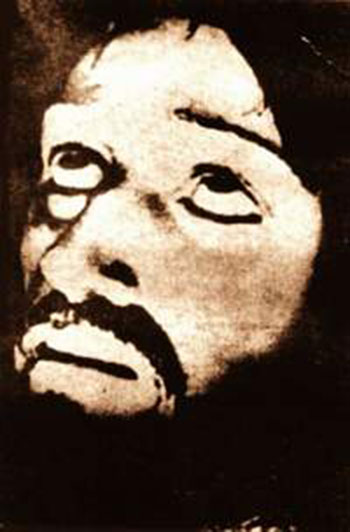|

by
Rennie
November 04, 2025
from
Medium Website
Article also here

Rome, May 2, 1972. Father
Pellegrino Ernetti sits across from
a journalist, about to make the most extraordinary claim of the 20th
century.
For years, he is kept a secret. A secret that involves the Vatican,
twelve brilliant scientists, and a machine that should not exist.
He has built a time machine.
Not a machine that travels through time. Something arguably
more profound:
a device that could observe the past.
A television that could tune into any moment
in history like changing channels.
And he has used it to witness - and photograph -
the crucifixion of Jesus Christ...
The resulting article hits newsstands with a headline that stops
Italy cold:
"A Machine that Photographs the Past has
Finally Been Invented"...
The photograph accompanying it shows Christ's
face, contorted in agony, taken, Ernetti claims, "directly" from
Golgotha, 33 AD...
The Vatican's response is swift and absolute:
Stop talking. Now...!
The question is not whether you believe him.
The question is:
Why
would a respected priest-scientist, a man with everything to
lose, stake his entire reputation on this story...?
The Machine
Rewind to 1952...
Father Pellegrino Ernetti is no ordinary monk.
At his monastery on the island of San Giorgio
Maggiore in Venice, he is known as,
one of Europe's leading authorities on
archaic music.
He is also a physicist, an exorcist, and a
man obsessed with a single problem:
Gregorian chants had been corrupted over
a thousand years of transcription.
He wanted to hear them as they were
originally sung.
His radical solution?
Build a machine that could capture sound
vibrations that had already dissipated into the past...
Every sound, he theorized, leaves an
electromagnetic trace in the environment.
What if you could detect those fading echoes?
What if you could build a receiver sensitive
enough to reconstruct voices from centuries ago?
According to Ernetti, he assembled an
extraordinary team. Twelve scientists...
Among them:
-
Enrico Fermi - Enrico Fermi -
Nobel Prize-winning physicist, creator of the world's first
nuclear reactor, architect of the atomic age .
-
Wernher von Braun - Former Nazi
rocket scientist, the man who would put America on the moon.
Together, they built what Ernetti called the
Chronovisor.
He described it as a cabinet of cathode ray tubes, dials, and
levers. Three antennae made of unknown metal alloys, each tuned to
detect different wavelengths of electromagnetic radiation. The
machine could be calibrated to specific coordinates in space and
time.
Turn the dials. Adjust the frequency. And watch history materialize
on a screen.
In his 1972 interview with La Domenica del Corriere, Ernetti
described what he would witnessed:
-
Marcus Tullius Cicero delivering his
famous speech to the Roman Senate in 63 BC
-
Napoleon in exile
-
The destruction of Sodom and Gomorrah
-
The Last Supper
-
And on January 12–14, 1956: the
crucifixion of Jesus Christ
He provided a photograph as proof. A grainy,
haunting image of a bearded man's face, eyes turned heavenward,
captured - he insisted - at the moment of Christ's death.
The Church ordered him into silence. The machine, Ernetti claimed,
was seized and hidden in the Vatican's secret archives, deemed too
dangerous for the world.
He would maintain this story for the next 22 years, until his death
in 1994.
But here is where things get interesting.
Now Let's Investigate What
Actually Happened
Time to pull back the curtain.
That photograph of Christ? The smoking gun evidence?
It lasted exactly three months before it was exposed.
In August 1972, a reader named Alfonso De Silva wrote to Giornale
dei Misteri magazine with an uncomfortable observation:
Ernetti's
"photograph from Golgotha" was virtually identical to a
wooden
sculpture in the Sanctuary of Merciful Love in Collevalenza, Italy.

Source
The sculpture
was carved in 1931 by Spanish artist
Lorenzo Coullaut
Valera - or possibly his son
Federico, who continued his father's
work after Lorenzo died in 1932.
Not just similar. Nearly pixel-perfect. Ernetti had simply
photographed the sculpture, reversed the image, and added some blur
to disguise the source.
When confronted, Ernetti went silent on the photograph. Years later,
after his death, a relative claimed he would confessed to
fabricating it.
So the photograph was fake...
But what about the machine itself?
The Scientific Reality Check
Let's examine Ernetti's theory charitably.
The idea that electromagnetic radiation persists indefinitely is not
technically wrong. Light and sound are wavelengths. They do radiate
outward through space, weakening but theoretically never vanishing.
Here is the problem: signal degradation and cosmic noise.
Imagine trying to hear a whisper from 2,000 years ago.
That sound has been:
-
Scattered by every object it's
encountered
-
Absorbed and re-emitted countless times
-
Drowned out by every other sound in
history
-
Overwhelmed by cosmic background
radiation
-
Dispersed across billions of cubic
kilometers of space
You are not looking for a needle in a haystack.
You are looking for a specific atom that was once part of a needle,
in a haystack the size of the solar system, while someone's running
a jet engine next to your head.
And even if you could detect these ancient
signals, you would need:
-
The exact spatial coordinates of the
original event
-
The precise frequency at which to tune
-
A receiver billions of times more
sensitive than anything we possess
-
A way to filter signal from noise with
impossible precision
-
Computing power to reconstruct coherent
images from scattered data
We can barely do this for radio signals from 100
years ago. For events from antiquity? Thermodynamically implausible.
The Team That Never Was
Now let's talk about those famous collaborators.
Enrico Fermi:
Died November 28, 1954, of stomach cancer in Chicago.
That is barely two years after the Chronovisor was allegedly built.
He never mentioned the project. Not in his extensive papers, not in
interviews, not in private correspondence. Nothing.
Wernher von Braun:
Was working on rockets for the U.S. military
under constant surveillance - first by the Nazis, then by American
intelligence. His entire life is documented. No gap exists where he
could have secretly worked on a Vatican time machine. He died in
1977, never having mentioned the Chronovisor once.
Father Agostino Gemelli:
Another alleged collaborator. Conveniently
died in 1959 - before Ernetti started telling his story publicly.
See the pattern? Every scientist who could confirm or deny the story
was either dead or provably elsewhere.
Ernetti never provided schematics. Never demonstrated the device.
Never allowed independent verification. Never showed the machine to
a single credible witness.
The Transcription That Proved Too
Much
Ernetti also claimed he would used the Chronovisor to watch - and
transcribe - the lost Roman play Thyestes by
Quintus Ennius, performed in
169 BC.
He published a fragment: about 120 lines.
Problem:
Classical scholars immediately identified
issues.
The Latin contained words and grammatical
constructions that did not exist until 200 years after Ennius
died.
It was like watching Shakespeare and hearing
him say "OK boomer"...
The text was too short to be a complete play.
And the style did not match other known Ennius
fragments.
Princeton University's Professor Katherine
Eldred - an expert on Thyestes - concluded it was,
"almost certainly a modern fabrication"...
So Why Did He Do It?
This is what haunts the story.
Father Pellegrino Ernetti was not a crackpot.
He was:
-
A published musicologist of international
reputation
-
A respected scholar of ancient languages
-
A professor trusted by the Benedictine
order
-
A serious exorcist who took his religious
duties seriously
He had everything to lose and nothing tangible to
gain.
Theory 1: Fame and attention.
Possible, but he did not capitalize on it. He
gave one major interview, then went silent when pressed. He
wrote no books. He did not tour. He did not profit.
Theory 2: Delusion.
Maybe he genuinely believed he would built
something. Maybe he convinced himself that static and visual
noise were glimpses of the past. Human brains are
pattern-recognition machines - we see faces in clouds, hear
voices in white noise. If you build a device expecting to see
Christ, your mind will find Him in the static.
Theory 3: A thought experiment gone wrong.
Some researchers speculate he intended it as
a philosophical exercise - testing how people respond to claims
from authority figures - but could not back down once it
spiraled.
Theory 4: Something else entirely.
This is the uncomfortable one. What if
Ernetti did build something - not a time machine, but an
experimental device - and had experiences he could not explain?
Not maliciously lying, not delusional, but genuinely confused
about what he would witnessed?
We will never know...
He died in 1994, maintaining to his final days
that the Chronovisor was real, even while allegedly
confessing the photograph was fake.
The Vatican's Suspicious Silence
The Vatican never debunked it.
They did not confirm it.
They did not deny it.
They told Ernetti to shut up and then...
nothing...
If it was obvious nonsense,
Why not just say so?
Why not publicly dismiss it and move on?
There is a widely repeated claim that in 1988,
the Vatican issued a decree threatening excommunication for anyone
using,
"an instrument of such characteristics."
This detail appears in countless articles, books,
and documentaries.
But here is the thing:
No one can find this decree. It is not in
Vatican archives. It is not in the
Acta Apostolicae Sedis (the
Vatican's official gazette).
It appears to be part of the legend
- repeated so many times it became "fact."
Maybe the Church just wanted to avoid the
embarrassment of a respected priest spreading wild claims.
Maybe
they were protecting Ernetti from himself.
Or maybe - and this is pure speculation - something about the story
made them nervous enough to enforce silence without outright denial.
What We are Left With
Let's be clear:
The Chronovisor almost certainly never
existed.
-
The photograph was faked
-
The scientists never confirmed
involvement
-
The physics don't work
-
The transcription was anachronistic
-
No physical evidence exists
But the psychology of the story? That is real...
Father Ernetti was intelligent enough to know his claims would be
scrutinized.
He was educated enough to understand the
scientific problems.
He was devout enough to know the theological
implications.
And yet he told the story anyway.
Maybe it was ego.
Maybe it was delusion.
Maybe it was a noble lie meant to inspire
faith.
Maybe it was something stranger that we will
never fully understand.
The Chronovisor story persists because it touches
something deep:
our desperate desire to see the past.
To settle history's mysteries.
To witness the moments that define our
beliefs.
No more arguments about what Jesus really
said. No more debates about historical events. Just... the truth,
playing on a screen.
That hunger - to turn faith into footage, to
make the invisible visible - that is why the legend survives.
Somewhere in the Vatican archives, legend says,
sits a cabinet full of dials and cathodes and mysterious alloys. Or
maybe it is just the fever dream of a brilliant man who wanted, more
than anything, to bridge the gap between faith and proof.
Either way, we are still searching.
And maybe that is the point...
PRIMARY SOURCES
|



